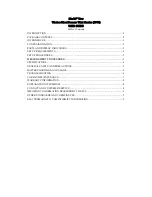
UK
Operating instructions FX460
43
9.16 Linearisation menu
In this menu the linearisation points are defined� Linearisation is only possible
in the SPEED, PROCESS TIME and COUNTER operating modes� This menu
is only displayed if the corresponding LINEARIZATION MODE is selected in the
GENERAL MENU�
Description and examples of the linearisation function:
P1(X) ... P24(X)
X coordinate of the linearisation point
This is the display value which the device generates without linearisation depending on the input signal�
-99999999
Lowest value
0
Default value
+99999999
Highest value
P1(Y) ... P24(Y)
Y coordinate of the linearisation point
This is the display value which the device is to generate instead of the X coordinate� For example, P2(X) is
replaced by P2(Y)�
-99999999
Lowest value
0
Default value
+99999999
Highest value
10 Linearisation
With this function, a linear input signal can be converted into a non-linear
visualisation (or the other way round)� 24 linearisation points are available� They
can be distributed across the whole conversion area at any distances� There is
automatic linear interpolation between 2 predefined coordinates�
It is recommended to set as many points as possible in sections where curves are
strongly bent� In sections with slight curve bending, only a few points are sufficient�
To predefine a linearisation curve the LINEARIZATION MODE parameter has to be
set to 1 QUADRANT or 4 QUADRANT (see diagram below)�
With the parameters P1(X) to P24(X) up to 24 X coordinates can be defined� They
correspond to the display values without linearisation�
With the parameters P1(Y) to P24(Y), you can enter the values which the display
should indicate instead of the X values� Value P5(X) is replaced by value P5(Y), for
example�
The X coordinates have to be assigned with continuously increasing values� That
means P1(X) is the lowest value; every following value must be higher� In case
of measured values that are higher than the X value that was defined last, the
corresponding Y value is constantly displayed�





































